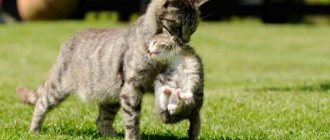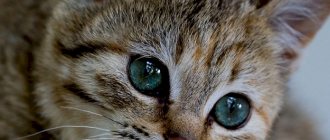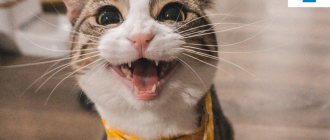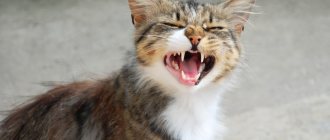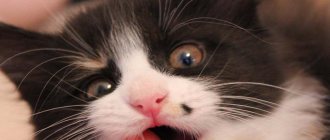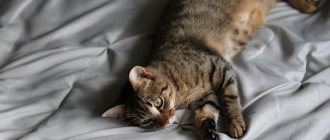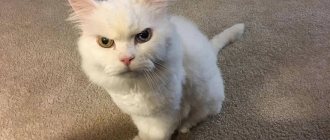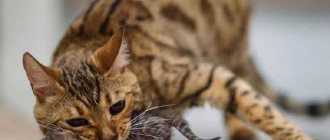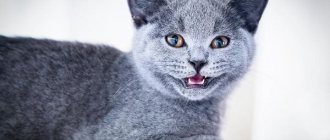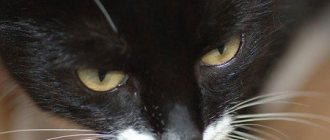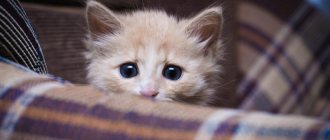What to do in such situations?
So that the cat has no reason to worry and remove its offspring from the equipped nest, the owner should take the following measures:
You can prevent this situation by preparing and arranging a box for the expectant mother in advance.
- Prepare in advance a comfortable, safe place where the cat can give birth to babies. Usually a closed cardboard box and a soft, warm bedding are enough for this.
- Protect from other pets. Other cats and dogs should not look into the house. A new mother must be sure that nothing will happen to her babies.
- Maintain a comfortable temperature in the room.
- Keep the litter clean. For convenience, you can line the bottom of the box with disposable diapers, which you can replace with new ones when dirty.
The cat should feel supported by the owner. If an animal is worried and behaves unnaturally, there are good reasons for this and it is important to find out them as soon as possible. If you can’t figure out on your own what the pet is not happy with and why she drags the kittens from place to place, it is better to seek advice from a veterinarian. Sometimes, to determine an accurate diagnosis, a comprehensive diagnostic study will be required, after which adequate treatment will be prescribed.
What are the main reasons for the transfer of kittens?
To understand the reasons for the transfer of kittens, it is important to understand at what point in time the kittens are carried:
- immediately after birth (plus/minus a few days);
- in 3-4 weeks.
If a cat carries kittens immediately after giving birth
The mother cat will most likely try to transfer her kittens during the first few weeks after birth. The kitten's movement may indicate that:
- the cat is nervous, there may be a lot of attention on your part;
- the cat has no experience and does not know what to do with the litter;
- she feels that the nest is unsafe and tries to hide the kittens;
- the nest is in an untidy condition, in other words, simply dirty.
The cat is nervous, perhaps a lot of attention from you
During the first few days after the kittens are born, interaction with the kittens should be kept to a minimum. It will be enough to check the condition of the mother and kittens, and that there is food in the bowl and that her litter tray is clean. If your cat is constantly nervous or agitated, have minimal contact with the cat for the first two weeks. After this time, the situation should return to normal.
It is known that during the first weeks of life, kittens cannot regulate their body temperature.
Therefore, they depend on the warmth of their mother. By the way, if “Murka” often moves her kittens, there is a risk that they may catch a cold.
Maternal aggression towards people and other animals is quite normal behavior in cats. But it will pass as the kittens grow older.
The cat has no experience and does not know what to do with the litter
For the most part, cats treat their kittens very well. However, if this is her first litter, then the situation may be completely different - even eclampsia.
Eclampsia is a critical decrease in the level of total calcium in the blood serum of a pregnant or lactating cat. As a result of calcium metabolism disorders, the amount of calcium in the body becomes below normal. This leads to a very serious, rapidly developing and dangerous condition - milk fever.
In this situation, there is certainly a danger that she may inadvertently harm her kittens.
At one time, we were almost “taken by Kondraty” when our cat began to hiss and rush at the kittens after the first birth.
The cat feels that the nest is unsafe and tries to hide the kittens
Most often, a cat will try to move her kittens on the second or third day after birth.
This is a necessary action in the wild. This way, they avoid predators who might be attracted by the scent of a recent birth.
Cats have a very hard time resisting ingrained instincts!
The nest is in an unkempt state
You must ensure that her nest and bedding are clean. A dirty place is one of the most common reasons why cats want to move their kittens. After all, they can’t wash the bedding themselves!
By the way, you can use regular disposable diapers and change them once a day.
The best place for kittens
To prevent the cat from dragging the babies around the room after giving birth, you should think about the location of the family in advance. To do this, it is necessary to prepare 3-4 nests a few days before lambing, let the furry mother choose the most suitable one herself. They need to be installed in a quiet room with shade. Places can be placed in the corners of the room to make the cat feel protected. It is advisable that there are no other animals nearby, the room is quiet and calm. Sometimes the best option, especially in apartments with children, is a wardrobe.
In any case, the place where the cat can hide the kittens should be dry, warm, and safe. Only in this case can we hope that it will suit the caring mother, and she will not look for another and drag the cubs.
To build a cat's nest, a cardboard box of the appropriate size is suitable. It can be lined with fabric and baby disposable diapers can be placed on the bottom. An exhibition tent is also perfect. It can be closed, which will prevent kittens from being dragged around at night and accidents to the cubs.
When the cat rolls, it will choose a place for itself from the nests pre-arranged by the owner. After this, fallback options must be removed.
The birth of kittens, feeding, caring for helpless animals, their protection and care are the natural instincts of any domestic cat. It is necessary for a person to interfere with these natural processes only if, for some reason, the cat is not satisfied with external conditions. In this case, the animal needs to be helped unobtrusively and delicately. This will not only reassure the new mother, but will also save the lives of the babies.
There are many reasons why cats eat their kittens. They are based on natural instincts. . As a rule, the female hides her nest from outside animals. But often a cat finds it and destroys the offspring.
Carefully observing the relationship between a cat and kittens, owners often notice that the pet does not show very warm and tender feelings towards its cubs. Reasons why cats bite their kittens.
From it you will learn about the reasons that force mothers to hide kittens, the undesirable consequences of such behavior, and what owners should do in this situation. . Why is a cat skinny, reasons why a cat is not.
If for some reason the nest was not prepared, then the first thing they should do is. The tray should also be located close to the box with the kittens so that the cat can safely go to the toilet without fear of leaving the cubs for a long time.
Kitten nutrition
Undesirable consequences
There are certain dangers in having a cat constantly traveling around the apartment with small kittens. When dragging the cubs, they may be injured. A cat can drop them from a height, and at this age a fall can be fatal.
When carrying the baby, the mother squeezes it quite tightly with her teeth, and when the kitten is already quite old, she drags it with drag. This situation can result in injury or death. Under no circumstances should you take kittens away from your pet while she is carrying them. The animal instinctively clenches its teeth tighter and can harm the baby.
Constantly carrying babies, the cat often forgets them. Without food and warmth, a helpless kitten may die.
What should owners do?
What to do if a cat carries kittens? This is the question that puzzles owners as they watch their pet looking for a new place for her offspring and transferring the cubs there.
First of all, it is necessary to understand the reasons that prompt the animal to such actions. Kittens should not be selected or placed in a place chosen by the owner. It is necessary to trace where the cat has found a new place and help build her a nest.
The animal should be denied access to places where the arrangement of a new place would be unsafe (balcony, space under the bathroom, etc.). Under no circumstances should you scold or punish a caring mother.
The animal obeys natural instincts and takes care of its offspring as nature dictates.
Owners sometimes misinterpret why a cat brings kittens to bed. You should not think that a caring mother entrusts her offspring to household members or brags about her kittens. Such feelings are alien to animals. The reason for the behavior is the search for a more favorable place for their offspring. And the master’s bed can be chosen as this place (warm, dry, clean).
There is also nothing touching about an animal dragging its cubs to a person. The reason why a cat brings kittens to the owner is, as a rule, a lack of food. The pet perceives humans as a source of food resources. As babies grow older, milk is no longer enough and they need solid food. This is why a cat brings its cubs to humans as a source of food.
We recommend reading the article about what owners should do when a cat sneezes. From it you will learn about the reasons that cause sneezing in a cat, home treatment methods and preventive measures.
What should an owner do when a cat carries kittens?
Even during the period of bearing offspring, the owner must ensure that the expectant mother is satisfied with the “maternity hospital” he has equipped. It would be better if it was a spacious box with low sides. It's called a nest. The place should be warm, without drafts, not too lit, quiet. The box should be ready about a week before the birth so that the cat can sniff everything and adapt to it. If a pregnant woman spends several nights in a nest prepared by the owner, this reduces the risk of subsequent dragging of offspring by the cat.
Never take kittens from their mother by force! Such actions can negatively affect the pet’s psyche. After all, after giving birth, she experiences stress. Just block access to places where the mother should not go with her kittens, for example, to the closet. If a nursing pet has chosen a secluded corner under the radiator, then help her make it more comfortable: put some bedding and block it with something.
If you suspect eclampsia, be sure to call a veterinarian at home. He will inject the cat with calcium gluconate, a sedative, and she will soon calm down.
Like any new mother, a cat who has given birth undoubtedly has more worries. Animals have a genetic instinct to care for their offspring, and even a young pet knows that her babies need warmth, food and protection. However, having no experience, she begins to drag kittens from one place to another. What causes this reaction?
Sometimes constantly dragging kittens can have serious consequences
So the question arises: what kind of trouble can happen if a cat carries kittens? Jumping from a height or climbing over a high box, a cat can drop a kitten and harm it. When holding a baby by the withers, a cat can clench its teeth tightly and injure it. That is why you cannot snatch kittens from a cat by force. It happens that a cat hides kittens in different places, and then forgets where exactly she hid each kitten. This can lead to the death of a baby, especially a very tiny newborn.
Having analyzed the reasons and bad consequences of a cat dragging kittens, we can move on to the question of what to do to ensure that the place chosen for the babies is liked by the cat and meets its needs for warmth and protection.
In other words, what to do if a cat constantly carries kittens.
Even during the cat’s pregnancy, it is necessary to find and prepare several secluded places so that the cat can independently choose the most comfortable place for her. Fence off those places in the house that, in your opinion, may threaten the safety of the cat and her kittens. In addition, the chosen location should not be noisy or crowded. Also, the cat does not accept a place that is too hot or too cold.
Possible risks
Transporting still fragile babies is unsafe, and in this case various tragic accidents are possible:
- Jumping over high obstacles or climbing to heights, a cat can drop a tiny baby and it will be injured.
- A cat sometimes clenches its teeth too tightly, for fear of dropping its load, which harms the kitten’s skin.
- When choosing a better place, the cat can take the kids to different places and even forget where each “cat child” is. This is especially dangerous for newborn babies.
- A place carefully chosen by mommy may be completely unsafe.
Naturally, no one is immune from tragic accidents, but owners should listen to the opinion of the pet. Even before giving birth, you can take a closer look at which place the “lady in labor” has chosen, and, if possible, install the box there. And most importantly, you cannot drag kittens if they are not in danger, as this will negatively affect the mental state of the pet who gave birth.
Why does a cat carry kittens?
The cat is not happy with the place
One of the reasons why a cat begins to drag her babies from place to place is that the young mother is not satisfied with the place chosen by the owner (“nest”). A huge number of external factors (uncomfortable temperature, bright lighting, drafts, dampness, close proximity to other animals or family members) can provoke a cat to move kittens to another place. The arrangement of the place can also play a role: the bedding should be clean and the room should be moderately spacious; a room that is too open with a large area may seem threatening and unprotected to the mother.
The cat's inexperience in motherhood
For a cat, the appearance of the first offspring is always a very exciting and stressful moment, which can cause an ambiguous reaction in the animal. The cat does not understand why the little kittens squeak, and, trying to calm them down, begins to move the cubs from place to place. The animal should be given time to get used to the new role.
Eclampsia
Eclampsia is a condition in which the level of calcium in an animal’s body drops sharply, which is accompanied by various disorders of the nervous system. The cat begins to have convulsions and tremors, and there may be increased salivation. Attacks occur both during pregnancy and within a month after childbirth. During an attack, the cat becomes irritable and nervous and begins to drag the kittens. This condition is very dangerous; it is strictly forbidden to assist the animal yourself. When the first symptoms appear, immediately show the animal to a specialist.
Breed specifics
Breed specifics also play a role in the behavior of the cat's mother. There are breeds that have an innate instinct to protect their offspring from predatory animals, expressed in excessive guardianship over the offspring. For example, representatives of the Bengal and Singaporean breeds constantly move their brood from place to place. They do this in order to throw predators off the scent and thereby protect their offspring.
Cat instincts and behavior
The habits, behavior and habits of pets are largely dictated by natural instincts and skills. What is the reason and why does a cat drag kittens from one place to another?
There may be several reasons why a cat may drag its kittens:
- The cat has no experience in motherhood and is constantly looking for more suitable places when carrying kittens.
- The conditions created by the owner for the cat and kittens are not suitable for the living and raising of animals. The female tries to move the kittens to other places in the house that, in her opinion, are more suitable for them. It's warmer, quieter, more comfortable and dry there.
- If a cat carries kittens by the withers, this may be considered specific to her breed. For example, a representative of the Bengal cat breed carries a kitten in her teeth in order to protect and hide it from potential predators and enemies.
- The cat carries older kittens so that they are closer to food resources, where the cat itself is usually fed.
- The cat carries the kittens for fire and life safety purposes, so that nothing bad happens to them.
- A particular cat disease is eclampsia, which can occur during the first month after birth. The prerequisites for the occurrence of disease in an animal may be poor living conditions, lack of calcium, genetic disorders and changes in metabolism.
Surprisingly, the kitten, as soon as it gets into its mother’s teeth when she is carrying it, immediately calms down and becomes quiet. Apparently, the cub instinctively feels that the cat is trying to save and protect him, to help her cub.
Among the particularly severe symptoms of feline eclampsia, when a cat drags kittens in her teeth, may be a prolonged aggressive and nervous state of the animal, heavy and rapid breathing, tremors of the head and limbs. With eclampsia, a cat carries kittens several times in a row, continuously doing this. The disease is treated in a hospital setting under the supervision of an experienced veterinarian.
Types of “safe” meat for cats
More than 80% of a cat's daily diet is meat. But, before feeding your mustachioed pet this product, you need to figure out which types of meat will be beneficial for the cat’s health and which types of this product can cause serious harm to the body.
First of all, you should focus on the following rules:
- the meat must be fresh;
- low-fat;
- without small and dangerous bones;
- no unpleasant odor.
You need to feed your cat high-quality meat, and not waste product that is not useful on the human table. From time to time, your pet can be pampered with offal and cartilage, always fresh and low-fat (no more than 200g per week).
To feed your cat, you can buy chicken, quail, lean lamb, beef, rabbit, turkey, horse, goat and beef.
Pork, duck, goose and fatty lamb are prohibited.
Now let's figure out in what form meat can be served to a domestic cat.
Grilled meat
Fried product is strictly prohibited for feeding domestic cats. After eating such meat, the animal may experience serious problems with the liver, stomach and other organs of the digestive tract. All this will lead to a lot of unpleasant health problems for the pet and will significantly shorten its lifespan.
Cooked meat
This meat can be given to a cat. It contains many nutrients that are beneficial for her body. The main thing is to cook the meat correctly: boil it in low-fat broth without salt and other spices.
And one more rule: you cannot give raw and cooked meat at the same time.
To digest these foods, the body will need to produce different enzymes, which will negatively affect the digestion process. This may manifest itself as vomiting, stool disturbances and other unfavorable symptoms.
Smoked meat
Smoked meat is very dangerous for the body of a small predator. It is unacceptable to feed your pet such a harmful product!
Raw meat
Raw meat is a natural food for domestic carnivores. In their natural environment, cats always feed on prey consisting of small rodents and birds. It’s clear that they consume their catch raw, without cooking.
To create a complete diet for a mustachioed pet, experts recommend combining meat with other healthy foods. For example, you can serve it with vegetable puree and olive oil. Or prepare a delicious soup from low-fat broth with herbs, butter and pieces of meat.
- fresh meat should be cut into pieces, distributed into bags in small quantities for one feeding and sent to the freezer for freezing;
- Meat should be frozen for 3-4 days or more;
- extreme cold destroys helminth eggs, which makes the meat product absolutely safe to feed cats;
- Before serving, the meat can be slightly warmed in the microwave or poured boiling water over it;
- It is better to defrost the product in a plate; after defrosting, juice from the meat will remain in it, which your furry friend will also happily sip on;
- Sometimes you can pamper your cat with raw minced meat, prepared yourself from fresh lean meat, without salt and spices.
What may not suit a cat?
Before considering the issue of properly arranging a place for a pregnant cat, it is worth considering the situations when she begins to move the babies and the possible reasons for this behavior:
- The cat is unhappy with the space provided to her. It can be inconvenient and not very safe due to incorrect temperature conditions - the place should not be too hot or too cold. It is also advisable that the box or basket is hidden from direct sunlight. In addition, cats are not inclined to show off their babies early, and a crowded place will also not meet her ideas of safety.
- The reason is the cat's inexperience. Yes, despite her innate instincts, sometimes a new mother does not understand why her babies begin to squeak, and tries to solve this problem by dragging them.
- Eclampsia. A serious illness during which blood pressure rises to a critical level in pregnant and postpartum individuals. The disease can develop for various reasons: due to a lack or excess of calcium in the body, due to poor or poor quality nutrition, due to impaired metabolism. The disease is accompanied by a number of symptoms - nervousness, increased aggression, difficulty breathing. Also, a cat often tirelessly carries kittens and cannot decide on a place. If the owner detects similar behavior in his pet, you should not wait for her condition to worsen, but should immediately contact a veterinarian. Otherwise, there is a risk of death.
- Specific breed characteristics. Representatives of some breeds have a very strong protective instinct, which is why they behave in such a way as to protect their kittens from possible predators. For example, Bengal cats tend to search for secluded places and can change the location of their offspring in order to throw predators off the scent.
